
 by Steven D. Johnson
by Steven D. Johnson
Racine, Wisconsin
This month:
•
JDS 2100-CKV Dust Collector Review
•
Pick A Pack Of Pucks
•
New Highland Woodworking Library Addition
•
Pet Steps – An Exercise In Scale
The "Cross-Over" Dust Collector
Click on any picture to see a larger version.
A "niche" market is a subset of a market for which a specific product is focused. For example, there is a vast market for tools… within that market there are subsets… do-it-yourselfers and professionals; automotive, metalworking, watchmaking, and woodworking tools; hand tools and power tools; high end and "popular-price" tools; and many, many more specialized and targeted niches. There are also subsets of subsets, or niches within niches. Woodworking might be considered a subset of the do-it-yourself market, lathe turning or carving might be considered a subset of woodworking, and a hand plane maker may focus on a subset of woodworkers that like to use hand tools rather than (or in addition to) machines.
A market niche defines successful product features and design. Sometimes, too, a product design can define or create a new niche. Think iPod, iPhone, and iPad, as stellar examples. Sometimes products can cross over and combine or "bridge" niches. Examples of children's books that become best sellers among adult readers abound, so-called "prosumer" mowers, weed-whackers, and tractors that appeal to power-hungry suburban wannabe farmers are crossover products, and there are many other examples of products that bridge niches.
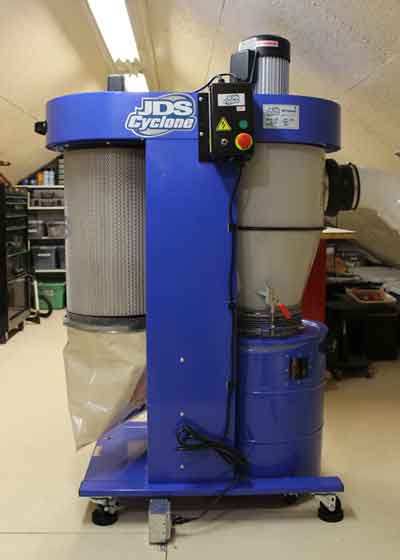
|
Figure 1 - Side-to-side just 40",
front-to-back 28", and 68" tall...
and an overall "beefy" 261 pounds!
|
In starting to write a review for the JDS 2100-CKV Dust Collector, I was struck by the perhaps unwitting, but entirely successful nature of the niche crossover JDS achieved with their "portable" dust collector.
For many years we woodworkers struggled to achieve adequate home (or small commercial) workshop dust collection with a choice between two very distinct niche-filling attempts. On the one hand were the tall stationary cyclone systems that showed little more engineering imagination than to simply scale down the size of their first-born commercial-size siblings, and on the other hand were the flimsy roll-about blower-bags that were (and still are) largely ineffective at doing anything other than collecting some large wood particles and chips and recirculating the fine (and harmful) dust back into the air. Way too many small woodworking shops, dissatisfied with the paucity of choice, chose to do nothing at all.
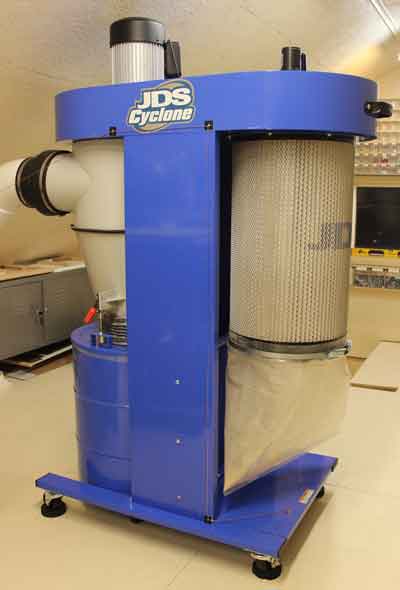
|
Figure 2 - Easy to remove and replace
dust bucket and four swiveling wheels
|
Much to the credit of retailers, magazines, a couple of progressive and thoughtful manufacturers, and a few vocal individuals, awareness of the deleterious effects of fine wood dust grew thereby creating a more viable market niche. Manufacturers responded, and eventually there emerged a class of "small shop" cyclone dust collectors. Not long after, the niche bifurcated, producing small-shop cyclones that were designed for permanent installation and those that were portable.
Now JDS has effectively produced a crossover product that is equally adept as a portable or as a stationary dust collection machine. The JDS is a true "hybrid" product, though it bills itself as a "portable" dust collector. How has JDS accomplished this and why is it important? Let's examine…
There are as many kinds, sizes, and layouts of woodworking shops as there are woodworkers… no two are alike. Your shop may be spacious, and rolling a portable dust collector about from machine to machine is easy and convenient. Your shop may be small, and a portable dust collector may fit, but it may be more convenient to roll your equipment out for use and hook it up to a dust collector that, while portable, actually never moves. You may desire the convenience, efficiency, and speed of work with a central dust collector plumbed to a ductwork network, but lack the space for a large unit intended for central stationary installation. Perhaps you want to install a dust collector in a separate adjoining space, but only a small portable unit will fit. Maybe your shop is in a basement and ceiling height is a choice-limiting factor. Maybe a combination system would work best in your shop… some ductwork to specific machines and a dust collector that stays in one spot most of the time, but on occasion can be disconnected from the ductwork and rolled out to use with a less-often-used woodworking machine. Or perhaps you simply enjoy experimenting with the layout of your shop, and anything installed "too" permanently limits your ability to rearrange.
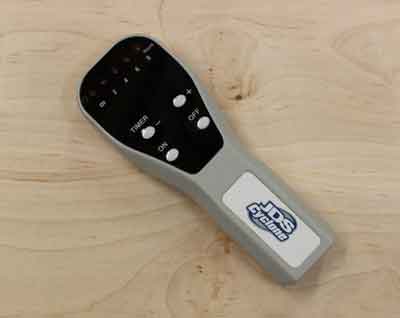
|
Figure 3 - The included remote is RF,
meaning it will work through walls
|
Most of the portable dust collectors on the market simply do not have the requisite power (air movement capability) to be effective when hooked to a ductwork system. Typically, the trade-off for size is power. Many units are too flimsy for day-to-day relocation from machine to machine. Most do not have a radio-frequency (RF) remote control that allows installation in another room or separate space, not to mention the need to knock the dust off the filter pleats periodically, which may not be convenient (or might be forgotten) if the dust collector is located outside the shop proper.
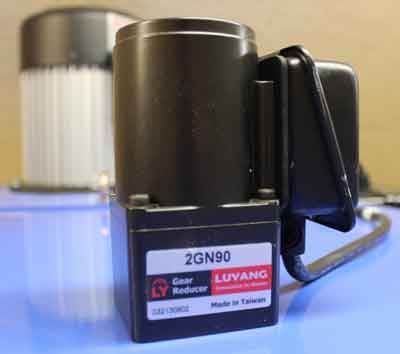
|
Figure 4 - This little gear motor saves
steps by automatically turning flappers
inside the filter to knock off the dust
|
JDS has addressed all these issues and opportunities with a machine that is small enough, both in height and footprint, to qualify as "portable" and yet ranks at the top of its class in power. The unit is easily moved, but as the heaviest among its class, is built tank-like to withstand the rigors of daily use and movement from machine to machine. The included RF remote works at significant distances, through walls and floors, so if you want to isolate the machine, as I did, it is easy. And you never have to worry about keeping the filter pleats clean and free of built-up dust, because the JDS is the only machine on the market that cleans those filter pleats for you, automatically.
Nothing, of course, is perfect, but the JDS unit is pretty close and has defined a new crossover market niche, capable of satisfying the needs of many, many woodworkers. Of course, as you might suspect, I do have a few suggestions that could make the JDS 2100-CKV even better. Forgive me, I can't help it.
Since the JDS can be installed permanently or used as a portable, is convenient, possesses high-power, is relatively small in height and footprint, is efficient and capable, my first suggestion is that the company begins to market this unit in exactly that way… "universal - permanent or portable, compact and powerful, fully automated dust collection."
Now to the specifics…
Shipment was timely, the selected carrier was outstanding, and the packaging was very good. The assembly is very straightforward and easy, but the instructions leave a fair bit to the imagination and intuition and there is even a typo. One important assembly step was completely left out. A little work on the instruction manual would be greatly appreciated and posting it on the web site for potential buyers is suggested… we all like to know ahead of time what we are in for when a machine arrives.
The fit and finish of the machine was meticulous. The parts were all there, down to every single nut, bolt, and screw. There is even an included wrench, which at first I thought was cheesy and unnecessary, but later found out was the only way to mount the wheels on the dust canister. And speaking of wheels, since the JDS has defined a new crossover niche, able to satisfy those who want a portable and those who want to install a system permanently, I suggest offering an option of same-height feet to replace the wheels on the main unit.
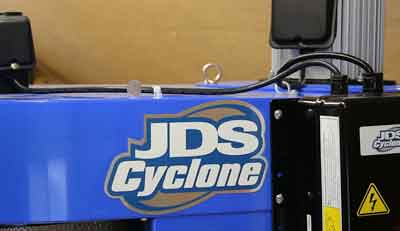
|
Figure 5 - Look close... there is a nickel balanced on
edge on top of the running machine... awesome!
|
Ever since I first saw the "nickel test" at a tool demo, I have been interested in machine vibration. On cutting and shaping tools vibration can impact accuracy, but as much as anything, low or no vibration indicates thoughtful engineering, careful assembly, and first class componentry. Nothing in my shop passes the "nickel test" (balancing a nickel on edge on the machine while it is running) except my Rikon band saw. Imagine my surprise when I was able to balance a nickel on edge on top of the JDS dust collector while it was running… a test I can repeat and the machine will pass every time. I suggest that JDS not only market the utility, fit, finish, and build quality of their dust collector but issue a challenge to other makers… "Can you pass the nickel test?" My old portable dust collector would not only have failed to pass the nickel test, but would have bounced the nickel across the shop, likely never to be found again. I can't afford that!
JDS specifications list the dB level as 74. I have not been able to replicate that, instead getting readings more in the mid-80dB range. My suggestion, not just to JDS but to all manufacturers, is that we agree to a standard methodology for sound measurements, i.e. distance, direction, weighting, etc.
All other machine specifications listed on the web site and in the literature were accurate, though there really is no universally followed methodology that allows direct comparison of the claimed CFM of a dust collector. Fortunately, whether or not we can really compare apples to apples, the JDS is producing more than ample power and CFM movement at every duct inlet location, well in excess of the 450 CFM recommended for most woodworking machines… and that through a ductwork system that includes some 35 to 40 feet of pipe, 5 inlets, 6 blast gates, a floor sweep, 6 wye connectors, an assortment of 22-?, 45, and 90-degree ells and lengths of connecting hose at each machine.
I would never suggest infringing on a patent, but some type of system to remotely alert users to a "nearly full" dust bucket would be an addition that would make this dust collector a pure "category killer." Uber-cool would be an alert sent to my iPhone… "Time to empty the dust collector." Well, we are all allowed a little fanciful dreaming from time to time.
The JDS 2100-CKV is a near-ideal unit, clearly positioned to cross over between niche requirements, whether you want to install your machine permanently, use it as a portable, or some combination of the two. The feature set is user-friendly, the power is way more than adequate, and the fit, finish, and engineering are first class. Highly recommended.
(Page 1 of 4)
1
2
3
4
Next Page
Return to Wood News front page
